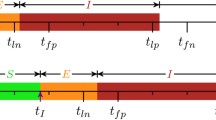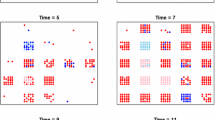Abstract
Foot-and-mouth disease (FMD) is a highly contagious viral infection of cattle, sheep, goats and pigs, with complex epidemiological interactions. State-transition simulation models have traditionally catered for complex modelling, yielding detailed representations that are well suited as predictive scenarios. However, results of serological investigations show a variance in antibody levels between segregated age groups on managed farms, and this has further complicated an intraherd model to the extent that a state-transition technique would become cumbersome. Moreover, the distinction between the acute and milder forms of the disease adds three more states to a conventional SIR framework, creating an APRISM model. Consequently a vector-transition technique has been employed. Vector-transition combines daily changes (in both the viral output of infected animals and the antibody titres of susceptibles) with the transition of herd animals between disease states. This means that the probability and herd matrices used in the state-transition approach are no longer required; the model is thus simplified and the processing load reduced. Vector-transition has direct applicability to FMD but could also be used to model similar micropopulation diseases.
Similar content being viewed by others
References
Anderson, R.M. and May, R.M. (1985) Vaccination and herd immunity to infectious diseases. Nature, 318, 323–9.
Carpenter, T.E. and Thieme, A. (1979) A simulation approach-to measuring the economic effects of foot and mouth disease in beef and dairy cattle. In Proceedings of the Second International Symposium on Veterinary Epidemiology and Economics, Canberra, pp. 511–16.
Dijkhuizen, A.A. (1989) Epidemiological and economic evaluation of foot-and-mouth disease control strategies in the Netherlands. Netherlands Journal of Agricultural Sciences, 37, 1–12.
Garner, M.G. (1992) Modelling foot-and-mouth disease in Australia. In Proceedings of the National Symposium on Foot-and-Mouth Disease, M. Nunn and P. Thornber (eds), Australian Government Publishing Service, Canberra, pp. 177–90.
Hafez, S.M. (1990) Studies on the control of foot-and-mouth disease in Saudi dairy farms. In Ministry of Agriculture and Water, and King Abdul-Aziz City for Science and Technology: Reports I and II, Riyadh.
Hugh-Jones, M.E. (1976) A simulation spatial model of the spread of foot and mouth disease through the primary movement of milk. Journal of Hygiene, Cambridge, 77, 1–9.
James, A.D. and Rossiter, P.B. (1989) An epidemiological model of rinderpest. I. Description of the model. Tropical Animal Health and Production, 21, 59–68.
Kitching, R.P. (1992) The application of biotechnology to the control of foot and mouth disease virus. British Veterinary Journal, 148, 375–88.
Kitching, R.P. and Salt, J. (1995) The interference of maternally-derived antibody with active immunization of farm animals against foot-and-mouth disease. British Veterinary Journal, 151, 379–89.
Marriott, F.H.C. (1970) Basic Mathematics for the Biological and Social Sciences. Pergamon Press, Oxford.
Miller, W.M. (1976) A state-transition model of epidemic foot and mouth disease. In New Techniques in Veterinary Epidemiology and Economics, Proceedings of a Symposium, P.R. Ellis, A.P.M. Shaw and A.J. Stephens (eds), Reading University, Reading, pp. 56–60.
Morris, R.S. and Anderson, G.A. (1976) Preliminary description of a computer simulation model of foot and mouth disease. In New Techniques in Veterinary Epidemiology and Economics, Proceedings of a Symposium, P.R. Ellis, A.P.M. Shaw and A.J. Stephens (eds), Reading University, Reading.
Moutou, F. and Durand, B. (1994) Modelling the spread of foot-and-mouth disease virus. In International Symposium on Ecopathology and Animal Health Management, Clermont-Ferrand, 18–20 October 1993. Veterinary Research, 25, 279–85.
Pech, R.P. and McIlroy, J.C. (1990) A model of the velocity of advance of foot and mouth disease in feral pigs. Journal of Applied Ecology, 27, 635–50.
Rossiter, P.B. and James, A.D. (1989) An epidemiological model of rinderpest. 2. Simulations of the behaviour of rinderpest virus in populations. Tropical Animal Health and Production, 21, 69–84.
Rweyemamu, M.M., Pay, T.W.F. and Simms, M.J. (1982) The control of foot-and-mouth disease by vaccination. Veterinary Annual, 22, 63–80.
Sanson, R.L. (1992) The development of a decision support system for an animal disease emergency, PhD Thesis. Massey University, Massey.
Schreider, Y.A. (1966) The Monte Carlo Method, Pergamon, New York.
Tinline, R.R. (1972) A simulation study of 1967–68 FMD epizootic in Great Britain, PhD Thesis. Bristol University, Bristol.
Author information
Authors and Affiliations
Rights and permissions
About this article
Cite this article
Hutber, A., Kitching, R. The use of vector transition in the modelling of intraherd foot-and-mouth disease. Environ Ecol Stat 3, 245–2551 (1996). https://doi.org/10.1007/BF00453013
Received:
Revised:
Issue Date:
DOI: https://doi.org/10.1007/BF00453013




